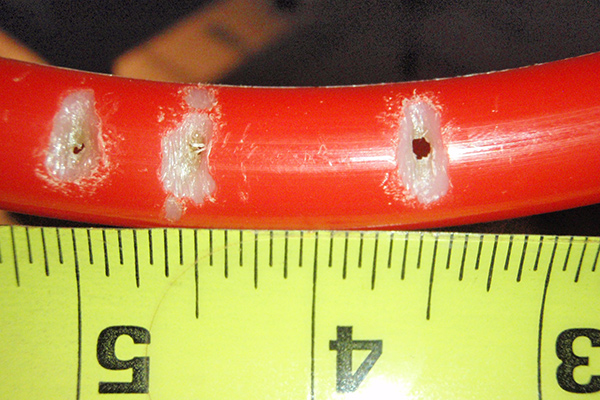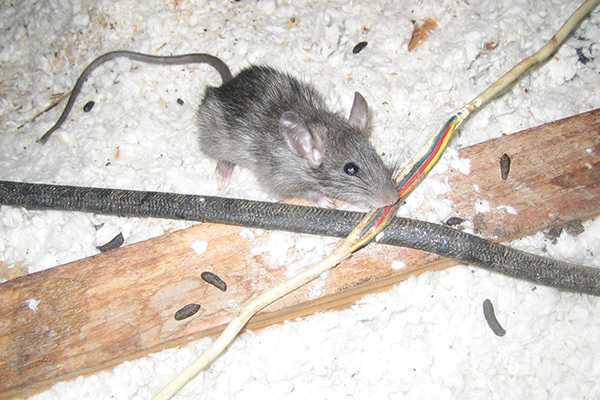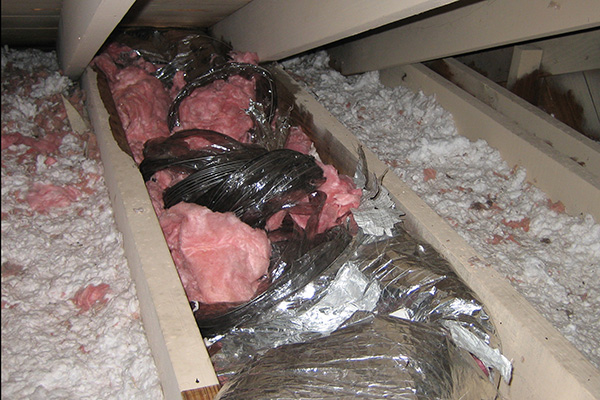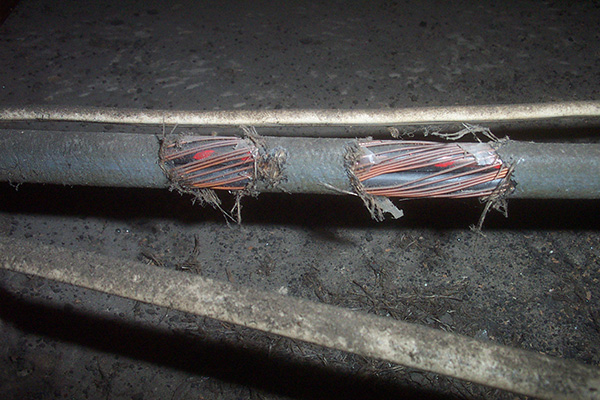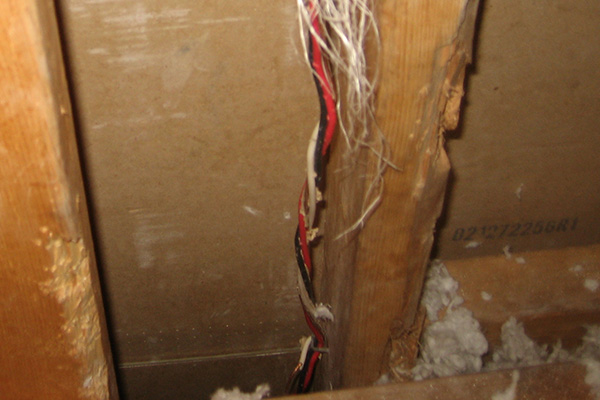- info@animalatticpest.com
- Call - we service 300 locations

What Damage Do Animals in the Attic Cause?
Animals can cause considerable damage in the attic, but not always. It depends on many factors, such as the length of time the animals have been in the attic, the type of animals the number of animals, the presence of electric wires or water pipes or lack thereof, they type of insulation, and so on. This is why a thorough attic inspection is important. You can get an understanding of what damage the animals have done. Look for trampled insulation, ripped ducts, animals feces and urine stains, and so on. Look for chewed wood, and play close attention to electric wires, to see if they have been chewed and constitute a fire risk. Also, sometimes animals in the attic will die, and keep in mind that a dead animal in the attic causes a terrible odor and flies! The feces and urine that the animals leave behind may cause slight odor problems, but more importantly are a potential source of pathogens or illness. Don't touch them! Waste left behind can also encourage the growth of mold, attract bugs like cockroaches, and contains a pheromone scent that will encourage new animals to enter the attic in the future.
Photographs of Rat Damage in the Attic
Photographs of Raccoon Damage in the Attic
Photographs of Squirrel Damage in the Attic
More Information About Animal Damage In the Attic
It is impossible to quickly say what damage animals cause in your attic or chimney. After all, every type of animal will do something different. Some will chew wires and insulation, while others will only chew certain items and yet others will just make a mess from waste and nesting material. That being said, there are a few types of damage to your attic that are more likely to occur in your attic when animals are present.
Damage From Droppings And Urine
Regardless of the type of animal in your attic, you will always notice some sort of damage due to droppings and urine. Since all animals eat and expel waste products, there will be the relevant effects. The droppings are likely to make a messy situation that is easier to clean up than most of the other types of damage wildlife can cause. Urine can be more serious depending on the number of animals present and where they go to the bathroom. Larger quantities of urine can moisten insulation, wood, and other materials to the point of encouraging mold growth or weakening the structure. In the best case scenario, you will have to replace urine-soaked insulation as a health risk and to reduce odors. Also droppings and urine can cause mold in the attic to grow.
Grease Stains
Some types of animals in the attic, such as bats and rodents, will leave stains behind on the areas that they go by more frequently. Bats, for example, have grease on their coats and they are likely to leave small brown stains by their most frequent entrances because of this. In fact, experts use these stains to find the bat entry points that need to be sealed up because they tend to exist so reliably. Also
read about Nest in the Attic - How to Remove Nests in House.
Removing Insulation
Depending on the animal in question, you may notice damage to the insulation that isn’t related to waste products. Rats, for example, may remove lining to create a nest, either within the insulation itself or by using smaller pieces of it to create a nest somewhere else and raccoons are also common culprits for this type of damage. In this case, you will find yourself with insulation spread throughout your attic, leaving you to pick up the pieces and then replace the damaged area. If you haven’t noticed the chewed or missing insulation, your home’s heating and cooling systems will be less efficient, costing you more money to keep it an appropriate temperature.
Chewing Wires
Certain animals, like rodents, squirrels, and raccoons, will also chew wires that they find in your attic, creating a serious issue. Chewed wires can create an extremely dangerous situation thanks to the fire hazard. If you are unaware of the damaged wires and continue to use the electronics they are linked to, there is a potential for short circuits or worse. If you are lucky, you will just get an electrical outage, but either is a possibility. Rodents have even been known to set off home alarms by chewing through wires. Keep in mind that while raccoons sometimes chew wires, they will also damage them with their claws, as will other animals.
Chewing Wood And Eaves
Certain animals, such as rodents, need to chew constantly to keep their teeth worn down and wood is an appetizing option for them. Sometimes, rats will also chew on the eaves or soffits in your attic and roof to get access to the nice, cozy space inside. In extreme cases where you don’t notice their presence for a long time or there are larger numbers, eaves and wooden beams may even be chewed through.
Holes In Walls
While smaller animals like rodents are limited in what they can damage, raccoons, squirrels, and other larger animals have stronger claws and can even rip holes in your walls, ceiling, or roof depending on the material used in construction. These creatures are determined and strong, which is bad news for your home if they decide they want to get somewhere and can’t find a path.
Damage To Stored Items
Most people use their attic for storing items they don’t need on a regular basis and this can lead to all sorts of issues and additional damage. If you have books, clothes, and paper, mice and rats may chew on this to create nests from the scraps. These rodents and other animals may also chew holes in furniture you have stored in your attic to create a snug nest under the upholstery. No matter what you have stored in your attic, a mouse or rat may chew on it and cause damage.
Ripping Ducts
In addition to some of the other damage already mentioned, raccoons are known to rip apart ducts as well. Experts aren’t sure why they do this but think it may be related to bedding material, curiosity, or fun. Of course, once your ducts are damaged, they aren’t able to carry air through your home as easily.


